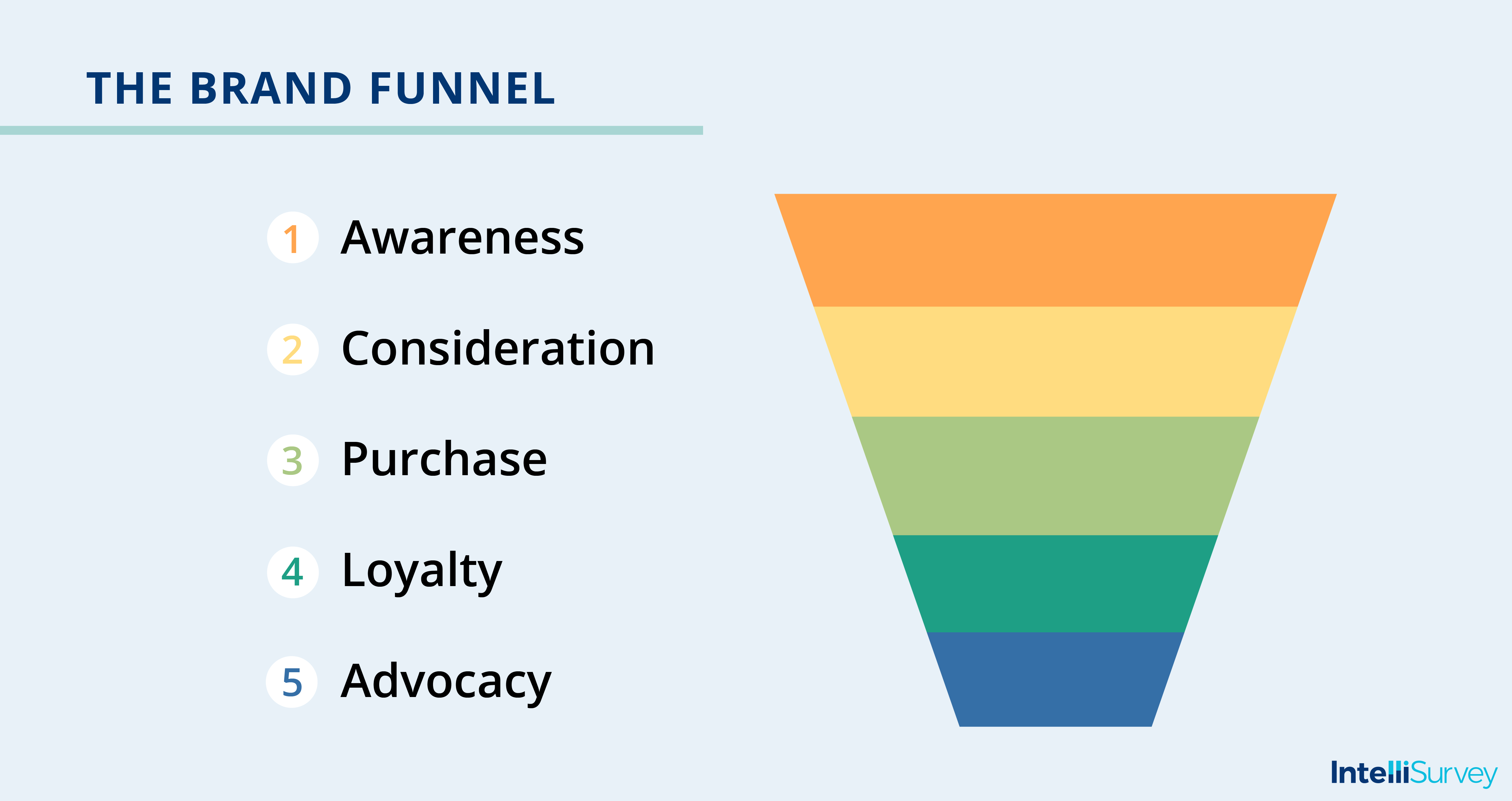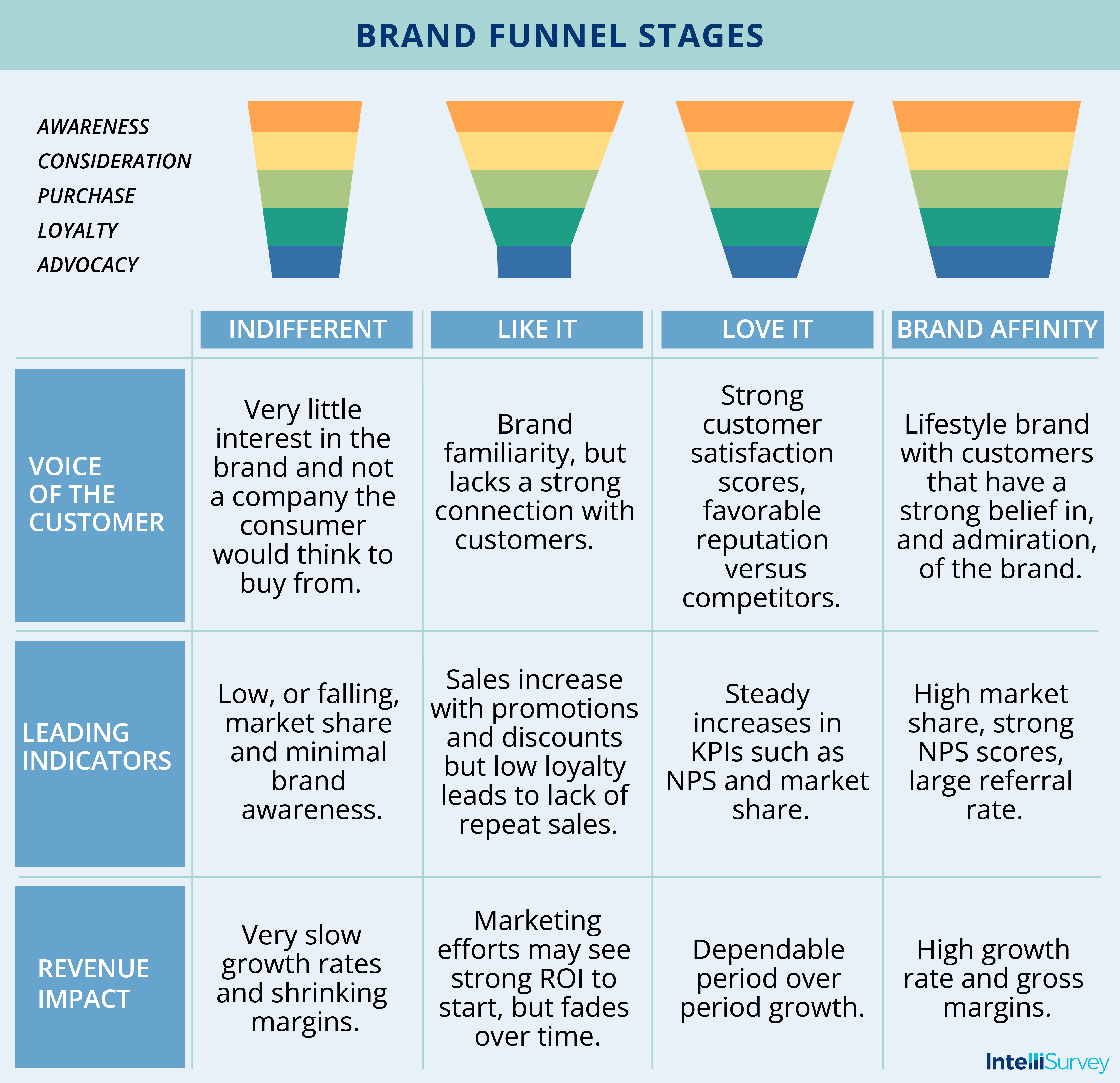Analyzing brand funnel metrics is crucial for any business wanting to understand its target market...
A brand funnel is a concept in marketing that explains the journey a customer takes from first encountering your brand to making a purchase. In a brand funnel, the customer moves through different stages of awareness and interest, eventually leading to a purchase and brand loyalty.
Brand funnels are a vital part of market research for measuring brand performance and growing brand awareness.
What Is a Brand Funnel?
A brand funnel is a model that illustrates a customer’s journey to brand loyalty. Brand funnels trace the process from initial awareness to purchase and advocacy. The steps of a brand funnel include:
- Awareness: How many people have heard of a brand?
- Consideration: How many people are considering buying from a brand?
- Purchase: How many people are choosing to purchase from a brand?
- Loyalty: How many customers have made repeat purchases from a brand?
- Advocacy: How many people actively recommend a brand to their friends and colleagues?

The Importance of Brand Funnels
A brand funnel can help a business determine the health of its brand. As a diagnostic tool, the strength of a brand funnel is that it assists companies in understanding when they are losing potential customers. In many cases, a brand funnel’s shape can indicate your business’s health in the market compared to your competitors.
For example, if a brand sees high awareness and consideration in the market but a steep dropoff when it comes to purchases, that might indicate that it is time to start learning why customers are choosing not to buy their products. Seeing a brand funnel that starts wider and narrows down toward the bottom could prompt a business to look into factors like reviews, end messaging, and packaging.
On the other hand, a brand might have a flat funnel, where many consumers who are aware are not buying. In this scenario, a business may focus on how to hit those missing targets and make even more potential buyers aware of them.
A brand funnel is a powerful tool because it helps businesses to diagnose where they are losing customers in the chain and understand where to invest in finding a solution.

Brand Funnel Stages
Awareness
Awareness refers to the percentage of people in a brand’s target market who recognize its name. This stage of the funnel looks at how many people have heard of a brand and how that number compares to its competitors and the overall market. Improving brand awareness is a critical component of any strategy; if more consumers are aware of your brand, that puts you in a better position to become competitive in your target market.
Consideration
Consideration looks at all the people aware of a brand and determines how many would consider purchasing. For a brand to be considered, it must provide services or products that align with the wants and needs of its target market. Consideration does not measure purchase, but it can give businesses a good indication of how their branding is perceived and the likelihood that people will buy their products when they are ready.
Purchase
This stage of the funnel is straightforward. The purchase stage measures how many people made a purchase from a brand at least once versus its competitors. In this stage, buyers have exhausted all their other options and determined that one brand’s offerings were the best over the rest of its competitors in the market.
Loyalty
Loyalty measures how many people make repeat purchases from a brand. This stage in the funnel looks at how many buyers have had a positive experience with a brand and made a repeat purchase because of it. The number (and cost) of these repeat purchases determines the level of loyalty the customer base has for a brand.
After the customer has made a purchase, the quality of the product will impact the outcome when it comes to determining brand loyalty. If a product or service can over-deliver on its promise, people will want to continue to use them over their competitors. Factors like checkout experience, delivery time, and customer support play a role in establishing brand loyalty.
Advocacy
Brand advocacy takes it up a notch from loyalty. Advocacy refers to the number of people who recommend a brand to their peers or colleagues after having a positive experience with their purchases. A returning customer will likely become an advocate, and happy customers will often tell others about their positive experiences.
Brands can encourage advocacy through a brand advocacy program, effective communication, and incentives.
Best Practices for a Brand Funnel Survey
Brand funnel surveys feature questions about various steps leading up to recent use and purchases to give researchers helpful insights about customer behavior. For example, a survey may begin by asking the respondent what brands they are aware of and end by asking which ones they have recently purchased from. The sequence of questions may resemble the following.
- Which of the following soft drink brands have you heard of?
- Coca Cola
- Sprite
- Pepsi
- Dr. Pepper
- Fanta
- None of the above
- Which of the following soft drink brands have you considered purchasing from?
- Which of the following soft drink brands have you purchased from?
- Which of the following soft drink brands have you purchased in the last 3 months?
Brand funnel surveys can help researchers identify trends within their target market through the use of similar questions. However, there are some best practices to keep in mind when making a brand funnel survey.
Avoid Long Brand Lists
While it is tempting to add as many brands as possible to ensure you are covering as much ground as possible, implementing long brand lists in your surveys can do more harm than good. After selecting a handful of brands, respondents may not review the whole list, which can yield inaccurate awareness figures. Respondents also may not bother reading through all brands if they have to scroll down for an extended period.
Avoid Using Different Units of Measurement
Using different units of measurement may lead to inconsistencies and muddle survey data. For example, a question should not ask about both usage frequency and time frames. To keep the survey and data clear and simple, split these into different questions like the ones mentioned below. Also be sure to watch out for phrases like most often used, main brand, preferred brand, and last purchased.
- When did you last use product A?
- How many times have you used product A?
Use Dummy Brands Carefully
Dummy brands are fake brands included in the brand list that can help identify overstatements and random clicking in surveys, similar to attention checks. However, dummy brands can
inadvertently identify honest respondents as survey offenders when used incorrectly. When implementing dummy brands in a brand funnel survey be sure to:
- Never use them for questions about every day, insignificant purchases
- Remember only usage is suspect, awareness can be influenced by other factors
- Ensure that a dummy brand is not the same as or similar to an existing brand
- Exclude respondents who select them from incidence calculations
Provide "None of these" and "Other" Response Options
Ensure that a multi-select list has a “none of these” to avoid forcing respondents to select an option. When deploying the “other” response in a question’s answer choices, ensure that the usage grid allows respondents to add a different brand. Only having the “other” answer selection is insufficient, as it does not give respondents a chance to add a brand to an awareness list.
Closing Thoughts
Brand funnels provide businesses with a helpful roadmap for customer engagement and conversion. They offer indispensable insights into the customer journey and the effectiveness of their marketing efforts.
Businesses that carefully monitor each stage of the funnel can continuously refine their marketing strategies and improve the odds of a successful conversion each time. A well-executed brand funnel often leads to increased brand awareness and customer loyalty, ultimately driving long-term business growth.
How IntelliSurvey Can Help
IntelliSurvey has a variety of market research services and survey software to help companies create an effective brand funnel with ad hoc performance trackers and advanced analytics to uncover drivers of happy or unhappy customers. With help from IntelliSurvey, your organization can better understand what factors are impairing or improving your brand’s overall customer experience.



